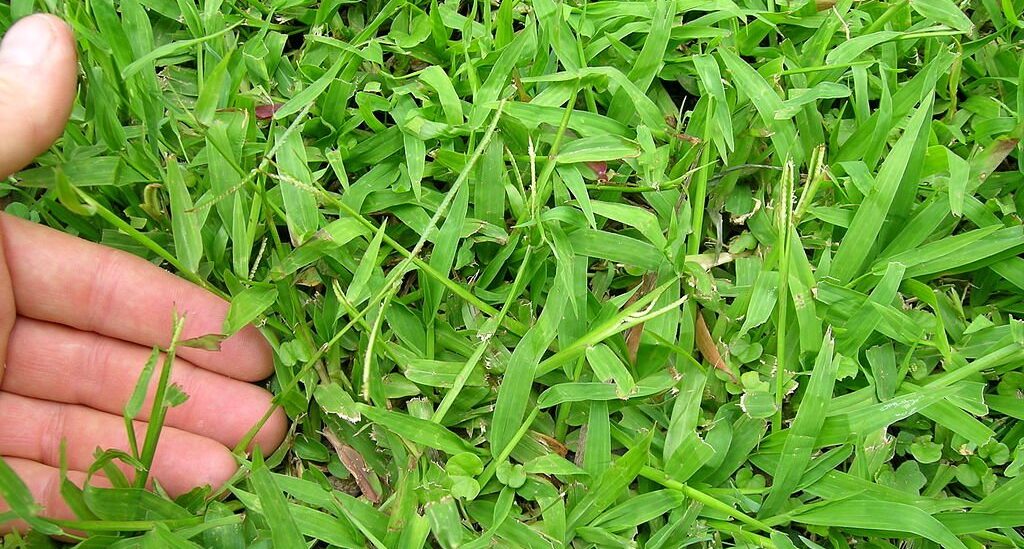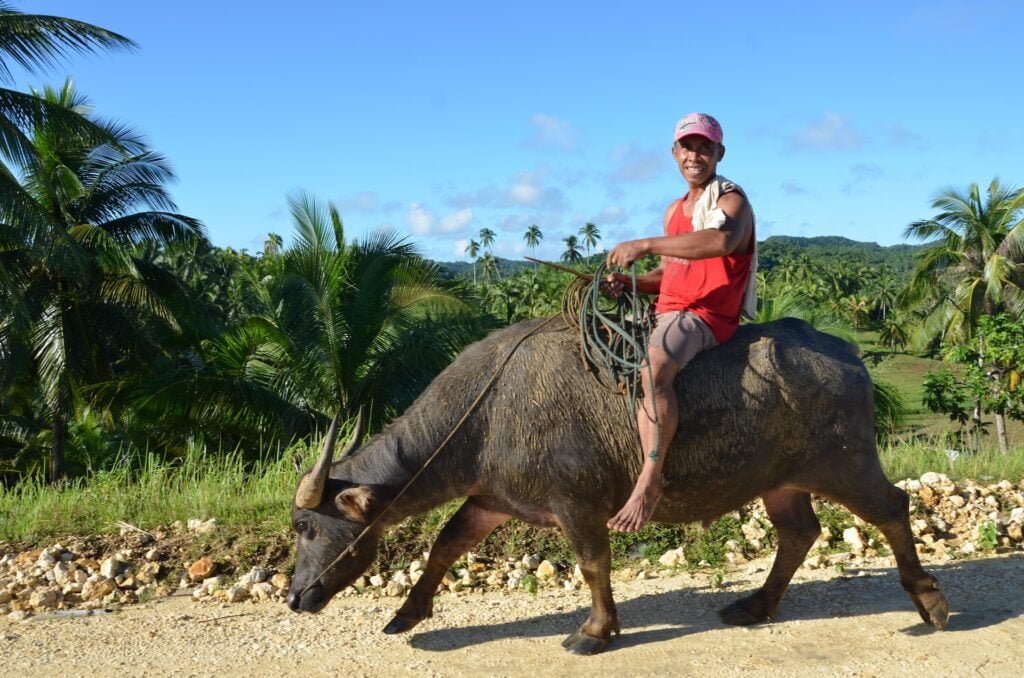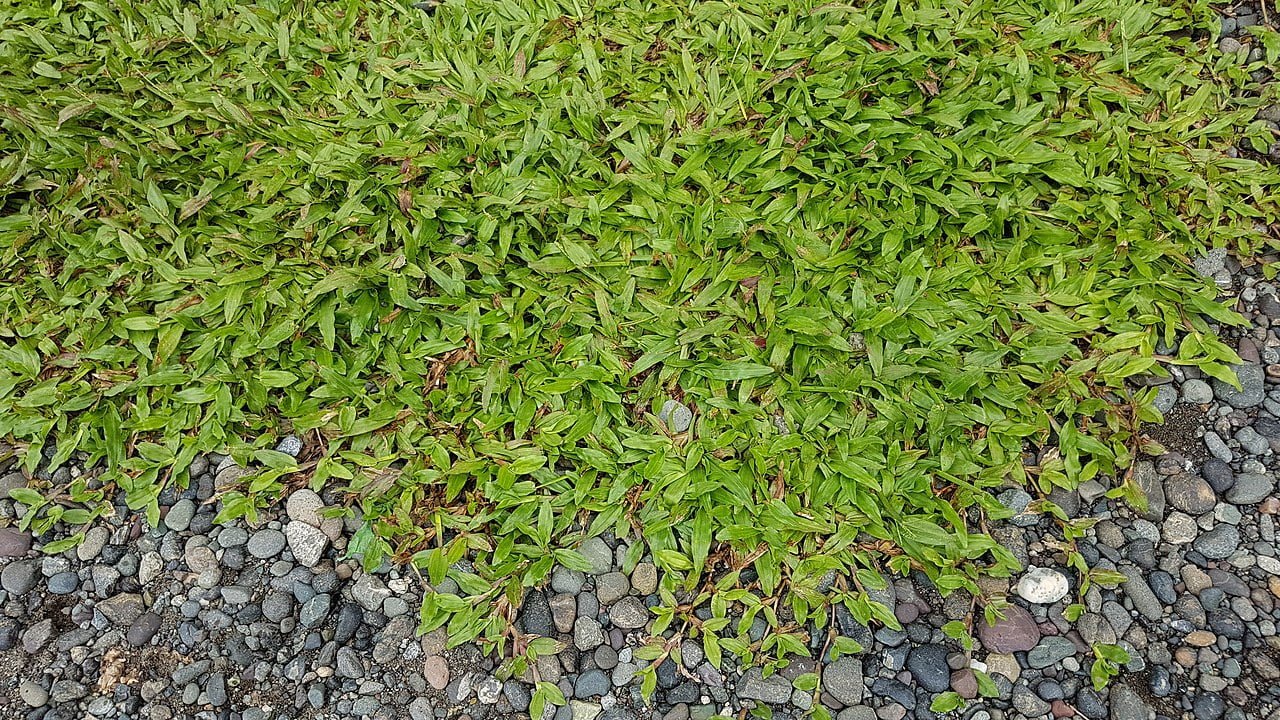Carabao grass is a perennial tropical grass species that’s widely recognized for its versatility and numerous applications. Abundant to the warm regions of Asia, this grass has become an essential part of agriculture, landscaping, and animal husbandry.
In this article, we’ll explore the various aspects of Carabao grass, from its characteristics to its uses and benefits.
Introduction to Carabao Grass

What is Carabao Grass?
Carabao grass, scientifically known as Paspalum conjugatum, is a low-growing, spreading tropical grass.
Native to the tropics of America, it was introduced to tropical Southeast Asia and the islands of the Pacific during colonial times. It has also spread to North Africa and northern and eastern Australia.
It features a deep green color and forms dense mats of foliage, thanks to its stoloniferous growth pattern. This versatile grass is highly adaptable to different soil types and climates, thriving in both sunny and shaded areas.
Known for its low maintenance requirements, Carabao grass is resistant to pests and diseases, making it an excellent choice for forage, erosion control, soil improvement, and landscaping purposes.
Why is it called Carabao Grass?

Especially abundant in the Philippines, Carabao grass gets its name from the Asian water buffalo, known as the “Carabao” or “Kalabáw” in Filipino. This nomenclature is a reflection of the grass’s significant role in the diet of these water buffaloes and its widespread use as a primary forage source for these animals.
The connection between the grass and the Carabao is deeply rooted in the cultural and agricultural history of the region, where these creatures are indispensable for various aspects of farming and transportation. As a result, the grass has come to be known as Carabao grass due to its close association with these iconic animals and their dietary preferences.
Characteristics of Carabao Grass
1. Appearance
Carabao grass has a distinct appearance characterized by its low-growing nature. It forms a vibrant carpet of deep green foliage that typically reaches a modest height of 15 to 30 centimeters.
Its dense mats of foliage create an appealing, lush aesthetic, making it a favorite choice for lawns and ground cover in landscaping.
2. Growth Pattern
This grass species has a stoloniferous growth pattern, which means it extends horizontally through above-ground stems known as stolons.
This creeping growth pattern allows the grass to rapidly spread and establish itself, making it an exceptional choice for ground cover. Its stolons create a thick, interlocking network, contributing to its effectiveness in erosion control and weed suppression.
3. Adaptability
Carabao grass is known for its remarkable adaptability to various soil types and climates. It thrives in both sunny and shaded areas, making it a versatile solution for various environmental conditions.
Its ability to flourish in a range of settings adds to its popularity, as it can be effectively utilized in a variety of landscaping and agricultural applications.
4. Low Maintenance
Once Carabao grass is established, it demands minimal maintenance, which is a significant advantage for those seeking a hassle-free landscaping or forage solution. This grass exhibits a high level of resistance to pests and diseases, reducing the need for chemical interventions.
Furthermore, it can withstand periods of drought, requiring less water compared to many other turfgrasses, making it an environmentally conscious choice for water conservation in landscaping and agriculture.
Agricultural Uses

1. Forage
One of the primary uses of Carabao grass is as a forage crop. It is highly nutritious and palatable to livestock, making it an ideal choice for cattle, goats, and other grazing animals.
Its lush and nutritious growth provides a reliable source of sustenance for these animals, contributing to their health and well-being.
2. Erosion Control
Due to its dense mat-forming nature, Carabao grass is effective in preventing soil erosion. It stabilizes soil on slopes and embankments.
The grass’s intricate network of stolons intertwines with the soil, creating a stable surface that anchors the earth, reducing the risk of erosion caused by wind and water.
3. Soil Improvement
Beyond its role in preventing erosion, Carabao grass actively contributes to enhancing soil quality. Its growth aids in improving soil structure by increasing its organic matter content.
This enrichment of organic matter enhances the soil’s fertility and water-holding capacity, ultimately benefiting crop production and agriculture as a whole.
4. Weed Suppression
When employed as ground cover, Carabao grass effectively suppresses the growth of undesirable weeds. Its vigorous and spreading nature competes with and inhibits the development of weeds, reducing the need for herbicides in agricultural settings.
This natural weed control not only simplifies maintenance but also promotes a more sustainable and eco-friendly approach to weed management in farming.
Landscaping
1. Lawn Grass
Carabao grass is a popular choice for lawns, particularly in tropical regions like the Philippines. Its low-growing, lush, and vibrant green appearance creates a visually appealing carpet-like effect, enhancing the aesthetics of outdoor spaces.
Its low-maintenance requirements make it an excellent option for homeowners seeking an attractive yet hassle-free lawn.
2. Ground Cover
Thanks to its spreading growth pattern and ability to form dense mats, Carabao grass is frequently selected as a ground cover in gardens and landscape design.
Whether it’s covering a large area or providing an attractive border, its versatility, and hardiness make it an ideal choice for adding greenery to various outdoor settings.
3. Shaded Areas
Carabao grass’s adaptability extends to shaded areas. It can tolerate partial shade, making it a valuable asset for landscaping in regions with trees or structures that cast shadows.
This versatility ensures that it can thrive in a range of garden layouts, even in areas where direct sunlight is limited.
Environmental Benefits
1. Carbon Sequestration
Grasses like Carabao play a crucial role in sequestering carbon dioxide from the atmosphere. This process aids in mitigating climate change by capturing and storing carbon, contributing to environmental conservation and sustainability efforts.
2. Habitat for Wildlife
The dense growth of Carabao grass provides an important habitat for small wildlife, insects, and beneficial organisms. It serves as a refuge for various creatures, fostering biodiversity and supporting the delicate balance of local ecosystems.
Tips for Planting and Maintenance of Carabao Grass
Planting
To establish Carabao grass successfully, it can be propagated through stolons or sprigs. It’s essential to plant it in well-prepared soil and ensure good soil-to-root contact for optimal growth and coverage.
Watering
While Carabao grass is drought-tolerant once it’s established, regular watering is crucial during the initial growth phase to promote healthy root development and a robust turf.
Mowing
The ideal mowing height varies depending on its intended use.
For lawns, maintaining a height of 3-5 cm is recommended. For forage purposes, a height of around 10-15 cm should be maintained to ensure the health and productivity of the grass.
Fertilization
Fertilize Carabao grass as needed, based on soil tests and growth patterns. Generally, it requires less fertilizer compared to other turfgrasses, which is advantageous for both cost-effective maintenance and environmental sustainability.
Common Questions and Answers About Carabao Grass
Q1: Is buffalo grass the same as carabao grass?
Buffalo grass and carabao grass are not the same. Buffalo grass, scientifically known as Bouteloua dactyloides, is a warm-season grass native to North America, particularly in the Great Plains region. It’s commonly used as a turfgrass in the United States. Carabao grass, on the other hand, is Paspalum conjugatum, native to Southeast Asia, especially in the Philippines. While they are both grasses, they belong to different species and have distinct geographic distributions.
Q2: Why is it called carabao grass?
Carabao grass is named after the carabao, a water buffalo commonly found in the Philippines and other parts of Southeast Asia. This grass is a staple food source for these animals, as they graze on it extensively. The name “carabao grass” highlights its significance as a primary food source for carabaos and other livestock in the region.
Q3: Is carabao grass low maintenance?
Yes, carabao grass is considered relatively low maintenance. It is known for its resilience and ability to thrive in a variety of conditions. It requires less water compared to some other grass varieties, and it can tolerate regular mowing and grazing, making it an excellent choice for lawns, pastures, and sports fields where minimal maintenance is desired. However, regular mowing and occasional fertilization can help keep it looking its best.
Q4: Is Carabao Grass safe for livestock grazing?
Yes, Carabao Grass is an excellent choice for livestock forage. It’s nutritious and palatable for various animals like cattle, water buffalo (carabao), and goats. The grass provides a good source of nutrition and is resistant to heavy grazing, making it a valuable feed option.
Carabao Grass: Nature’s Green Wonder
In conclusion, Carabao grass is a versatile and hardy plant with a range of applications in agriculture, landscaping, and environmental conservation. Its adaptability, low maintenance requirements, and numerous benefits make it a valuable resource for various purposes.
Whether you’re a farmer, a landscaper, or simply a homeowner looking for an attractive, low-maintenance lawn, Carabao grass is an excellent choice.
Also Read: Copper Gardening Tools: A Durable and Aesthetic Choice
Well, what do you think about the article?
Did you enjoy reading “Carabao Grass: Your Guide to a Greener Landscape“? We really hope that you have enjoyed this article. If you have any thoughts or comments about this post, please feel free to share them in the comment section below. We appreciate your feedback and would be glad to hear from you.
To see more content like this check the gardening section of Money For My Beer.

Lara is a freelance content writer and a cat mom to three furbabies, Mizu, Haru and Sora.
She graduated with a Bachelor’s Degree in Architecture and is a registered and licensed Architect. Aside from writing, she is fond of growing cacti and succulents and is a DIY type of girl.
During her free time, she engages herself in water-colouring and crocheting, while catching-up with an old tv series she just discovered. Lara loves to explore new places, but most of the time stays in her hometown province, reading historical romance novels over a cup of coffee – or matcha.

